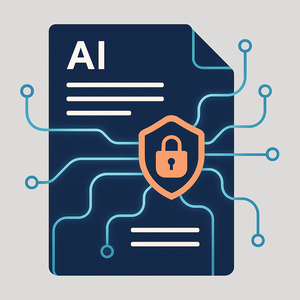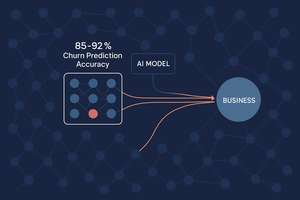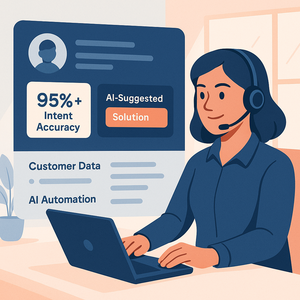Navigating the AI Transformation Tightrope: Balancing Innovation, Regulation, and Human Capital
The artificial intelligence landscape in late 2025 presents a complex picture of immense opportunity tempered by significant operational challenges....
6 min read
 Peter Vogel
:
Jun 9, 2025 3:40:35 AM
Peter Vogel
:
Jun 9, 2025 3:40:35 AM


AI is increasingly demonstrating its value not as a standalone tool, but through seamless integration with existing enterprise applications. This allows artificial intelligence to access and act upon data within familiar systems, promising substantial gains in operational efficiency.
Organisations are finding that embedding AI directly into daily workflows can automate tasks, generate complex reports, and action tasks across various tools. For instance, AI models can analyse data from project management tools to summarise team progress, identify blockers, and offer strategic recommendations, tasks that would traditionally consume significant human hours. Integrating AI in this manner helps to streamline processes and free up valuable employee time and resources.
However, implementing such deep integrations requires careful consideration. Businesses must address technical challenges related to connecting disparate systems, ensure robust data security and privacy protocols are in place, and manage the organisational change needed for teams to adopt AI-driven workflows effectively.

AI-generated video is rapidly advancing in both realism and narrative capability, opening up new possibilities for content creation at scale across marketing, communication, and training. This technology allows for the creation of highly realistic visuals and the sequencing of scenes to tell compelling stories.
The ability to generate video content with increasing fidelity means organisations can produce marketing materials, social media videos, and training modules more efficiently than ever before. This allows for rapid prototyping of creative concepts and potentially reduces reliance on traditional, time-intensive production methods.
However, the advancement of AI video generation also brings implementation challenges that must be addressed responsibly. Maintaining brand consistency across AI-generated content, addressing ethical concerns related to deepfakes and synthetic media, and ensuring the factual accuracy of visuals and narratives are critical considerations for any organisation looking to leverage this technology.

The way users discover information online is fundamentally changing due to the rise of AI-driven search and content summarisation. This shift is altering traditional content monetisation models and requires digital publishers and businesses to adapt their online visibility strategies.
As AI systems become more adept at providing direct answers and summaries, users are increasingly obtaining information without clicking through to original source websites. This trend, sometimes referred to as ""zero-click searches,"" reduces traffic to publishers and content creators, undermining business models reliant on advertising revenue or click-through conversions. Industry observers note this necessitates a move away from traditional SEO tactics focused solely on ranking for keywords and towards strategies that optimise content for consumption by AI models and inclusion in AI-generated summaries.
The practical implications for organisations relying on digital content are significant. Businesses must explore alternative monetisation models beyond traditional advertising, such as subscription services, premium content offerings, or direct licensing of content to AI companies. Furthermore, adapting content creation and SEO strategies to meet the needs of AI models – focusing on structured data and clear, context-rich information – is crucial to maintain online visibility in an AI-dominated discovery landscape. Implementing technical solutions to control content access and monitor how AI crawlers interact with digital assets are also becoming increasingly important.

Artificial intelligence is poised to significantly reshape the job market, requiring proactive adaptation and substantial reskilling initiatives across industries. This impact is particularly relevant for entry-level white-collar roles, which often involve tasks ripe for automation.
Reports indicate a notable increase in the automation of white-collar tasks. For instance, McKinsey (May 2025) noted that 20% of white-collar tasks were fully automated in 2025, up from 8% in 2023. Goldman Sachs (2025) projected that 65% of entry-level tasks are automatable, potentially impacting millions of jobs in the UK and EU by 2027. PwC (2025) corroborated this, stating 65% of entry-level tasks are automatable with current AI tools, compared to 35% for senior roles. While automation may lead to job displacement in certain areas, it also creates demand for new skills and roles. The World Economic Forum (2025) expects 12 million new AI-related roles globally by 2030, focusing on areas like ethics and implementation.
The rapid pace of change necessitates proactive adaptation from both organisations and individuals. McKinsey (April 2025) found that 68% of displaced workers cite ""insufficient AI literacy"" as a reskilling barrier, highlighting a critical skills gap. Gartner (March 2025) reported that while 41% of workers fear job loss to AI within 3 years, only 12% receive employer-led reskilling. Businesses must invest heavily in training programmes to equip their workforce with the necessary skills to collaborate with AI, focusing on AI literacy, critical thinking, and problem-solving. Deloitte (April 2025) noted that 83% of IT leaders reported improved compliance through AI governance tools, indicating a shift towards roles focused on managing and overseeing AI systems. Addressing resistance to change and resource constraints in implementing large-scale reskilling initiatives are key challenges.

As AI becomes increasingly embedded in business operations, the imperative for responsible implementation and robust governance frameworks has never been greater. Regulatory bodies globally are moving to mandate transparency and accountability for AI deployments, particularly in high-impact sectors.
The EU AI Act has entered full implementation, introducing rigorous requirements for risk assessment and transparency for AI systems used in areas such as employment, credit scoring, and law enforcement. This regulatory push is mirrored by growing public demand for transparency. Deloitte (2025) reported that 89% of CIOs feel pressure to prioritise ethics over deployment speed, reflecting broader concerns about AI decision-making. The EU AI Observatory (February 2025) found that 55% of AI projects fail ethics audits, underscoring the challenges in meeting these standards. Addressing bias in training data and algorithmic decision-making remains a key challenge, with a Stanford HAI audit (June 2025) reporting 42% of AI-related lawsuits in 2025 cite algorithmic bias in hiring tools.
Establishing clear ethical frameworks, ensuring compliance with evolving regulations, and building transparency into AI systems are crucial steps for organisations. TechUK (May 2025) reported that 73% of FTSE 350 companies now have dedicated AI ethics boards, indicating growing corporate focus on this area. Organisations with transparent and ethical AI practices stand to gain a competitive advantage, enhancing consumer trust and brand reputation, while mitigating legal and reputational risks associated with biased or non-compliant AI.

The artificial intelligence landscape in late 2025 presents a complex picture of immense opportunity tempered by significant operational challenges....

The discourse surrounding artificial intelligence is maturing. Across boardrooms and operational teams, the conversation has decisively shifted from...

The artificial intelligence landscape is no longer a distant frontier; it's rapidly reshaping the present, demanding a strategic response from...